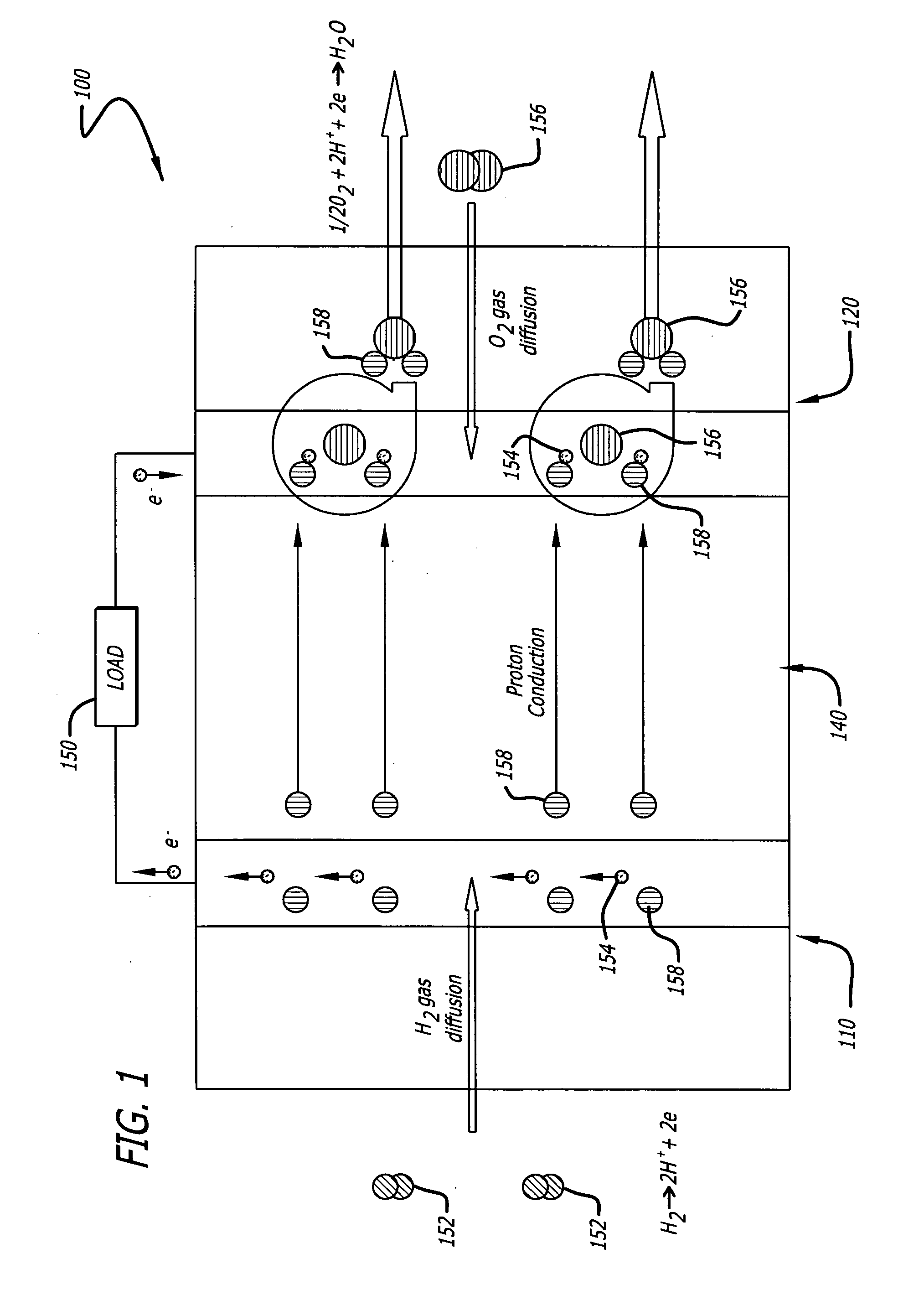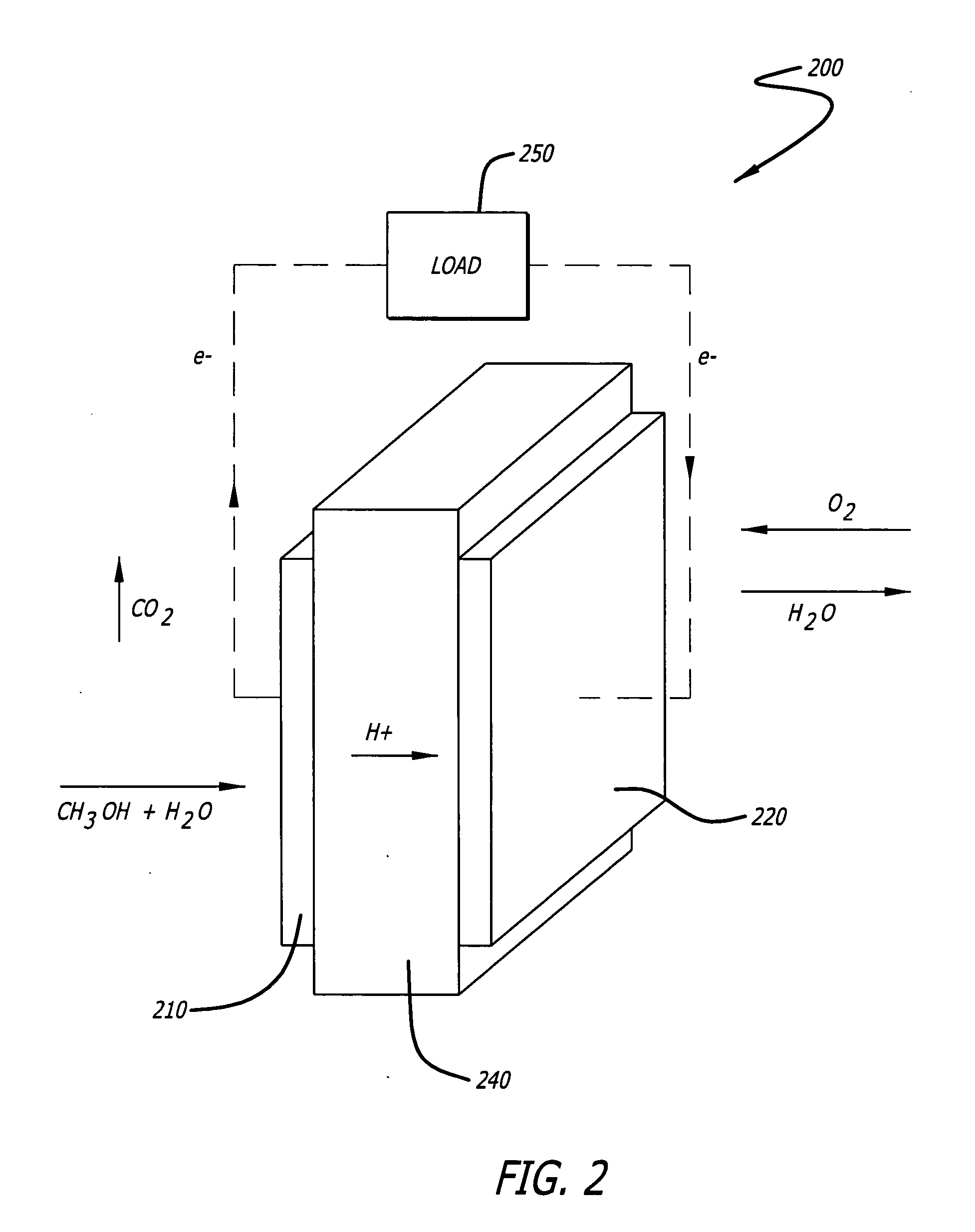Carbon based electrocatalysts for fuel cells
- Summary
- Abstract
- Description
- Claims
- Application Information
AI Technical Summary
Benefits of technology
Problems solved by technology
Method used
Image
Examples
example 1
Single-Walled Carbon Nanotubes
Process A:
[0105]1) Weigh SWNTs 1.00 g, put it into flask (250 mL with 3 necks);[0106]2) Add 120 mL 2M H2SO4+4M HNO3 into the flask, stir it at 1000 rpm for 10 minutes (min) at room temperature;[0107]3) Ultrasonicate it for another 20 min;[0108]4) Put the flask in a mantle heater (1000 rpm), increasing temperature to 110° C. for eight hours;[0109]5) Dilute the solvent by adding another 200 mL DI water in the above-mentioned flask;[0110]6) Filtrate it by normal filter paper and then by copious water (1 L hot DI water, 85° C.) in batches;[0111]7) Put the funnel with the filter paper and filtrate cake into a convection oven at 110° C. for eight hours;[0112]8) After drying, put the support into a glass bottle for later use.
Process B:
[0113]1) Weigh SWNTs 1.00 g, put it into the flask (500 mL with 3 necks);[0114]2) Add 150 mL EG into the flask and stir it for 10 min;[0115]3) Ultrasonicate it for another 20 min (suspension becomes ink);[0116]4) Put the flask in...
example no.2
Example No. 2
Dual-Walled Carbon Nanotubes
Process A:
[0145]1) Weigh DWNTs 1.00 g, put it into flask (250 mL with 3 necks);[0146]2) Add 120 mL 2 M H2SO4+4 M HNO3 into the flask, stir it at 1000 rpm for 10 min at room temperature;[0147]3) Ultrasonicate it for another 20 min;[0148]4) Put the flask in a mantle heater (1000 rpm), increasing temperature to 110° C. for eight hours;[0149]5) Dilute the solvent by adding another 200 mL DI water in the above mentioned flask;[0150]6) Filtrate it by normal filter paper and then by copious water (1 L hot DI water, 85° C.) in batches;[0151]7) Put the funnel with the filter paper and filtrate cake into a convection oven at 110° C. for eight hours;[0152]8) After drying, put the support into a glass vial for later use.
Process B:
[0153]1) Weigh DWNTs 1.00 g, put it into the flask (500 mL with 3 necks);[0154]2) Add 150 mL EG into the flask and stir it for 10 min;[0155]3) Ultrasonicate it for another 20 min (suspension becomes ink);[0156]4) Put the flask i...
example no.3
Example No. 3
Cup-Stacked Carbon Nanotubes
Process A:
[0186]1) Weigh CS-CNTs 1.00 g, put it into flask (250 mL with 3 necks);[0187]2) Add 120 mL 2M H2SO4+4M HNO3 into the flask, stir it at 1000 rpm for 10 min at room temperature;[0188]3) Ultrasonicate it for another 20 min;[0189]4) Put the flask in a mantle heater (1000 rpm), increasing temperature to 110° C. for eight hours;[0190]5) Dilute the solvent by adding another 200 mL DI water in the above mentioned flask;[0191]6) Filtrate it by normal filter paper and then by copious water (1 L hot DI water, 85° C.) in batches;[0192]7) Put the funnel with the filter paper and filtrate cake into a conventional oven at 110° C. for eight hours;[0193]8) After drying, put the support into a glass bottle for later use.
Process B:
[0194]1) Weigh CS-CNTs 1.00 g, put it into the flask (500 mL with 3 necks);[0195]2) Add 150 mL EG into the flask and stir it for 10 min;[0196]3) Ultrasonicate it for another 20 min (suspension becomes ink);[0197]4) Put the f...
PUM
 Login to View More
Login to View More Abstract
Description
Claims
Application Information
 Login to View More
Login to View More - R&D
- Intellectual Property
- Life Sciences
- Materials
- Tech Scout
- Unparalleled Data Quality
- Higher Quality Content
- 60% Fewer Hallucinations
Browse by: Latest US Patents, China's latest patents, Technical Efficacy Thesaurus, Application Domain, Technology Topic, Popular Technical Reports.
© 2025 PatSnap. All rights reserved.Legal|Privacy policy|Modern Slavery Act Transparency Statement|Sitemap|About US| Contact US: help@patsnap.com



